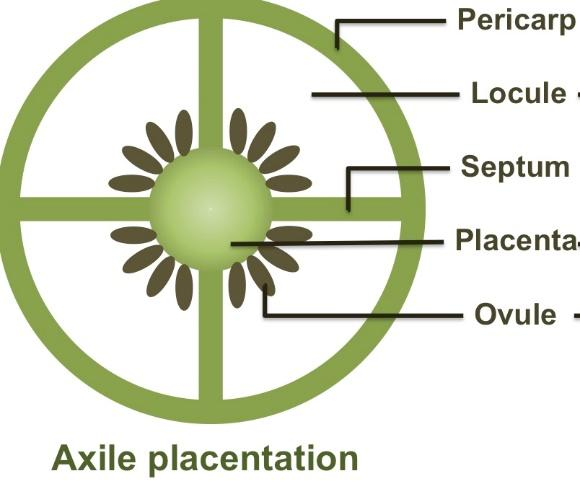
Where can Axile Placentation be seen?
Answer
490.8k+ views
Hint:Placentation is defined as the arrangement of ovules inside the ovary. In the flowering plants, there are numerous types of placentation. Free central (septa is absent), parietal (ovules at inner wall or periphery), marginal (ovules at ridge through the ventral suture of ovary), axile (around the ovary’s centre) and basal (in base of ovary) are the different types of placentation.
Complete answer:
The ovules are axial in the axial placentation. China rose, tomato, cotton and lemon are the examples of the plants exhibiting axial placentation. It is usually seen in multilocular ovaries, where the placentation is present along the axis of the fusion of ovaries. The arrangement is common in liliaceae, rutaceae and solanaceae families. Hibiscus rosa-sinensis exhibits axial placentation. The ovules are arranged along the placenta's central axis. Radial spokes section the ovary with placentae in distinct locules. The number of chambers present is equivalent to the number of carpels. The placentation can be seen in bicarpellary, multicarpellary and multilocular ovaries. It occurs in syncarpous pistils. Ovaries are divided into two or more chambers. Placenta occurs in the centre, where the septae get together, forming axile columns with the formation of ovules. In shoe flowers (pentalocular), it can be seen. In lemon, around the compound ovary, ovules are seen on an axis, which are formed from a jointed septae.

Note:
Ovules are attached inside the flower’s ovary via funiculi. Funiculi is the counterpart of umbilical cord. The funiculi attach to the part of the ovary, which is called the placenta. Placentation’s main function is to connect walls of the ovary with the flower. Placenta helps in providing nutrients to the developing embryo. It serves as a cushion-like structure for connection.
Complete answer:
The ovules are axial in the axial placentation. China rose, tomato, cotton and lemon are the examples of the plants exhibiting axial placentation. It is usually seen in multilocular ovaries, where the placentation is present along the axis of the fusion of ovaries. The arrangement is common in liliaceae, rutaceae and solanaceae families. Hibiscus rosa-sinensis exhibits axial placentation. The ovules are arranged along the placenta's central axis. Radial spokes section the ovary with placentae in distinct locules. The number of chambers present is equivalent to the number of carpels. The placentation can be seen in bicarpellary, multicarpellary and multilocular ovaries. It occurs in syncarpous pistils. Ovaries are divided into two or more chambers. Placenta occurs in the centre, where the septae get together, forming axile columns with the formation of ovules. In shoe flowers (pentalocular), it can be seen. In lemon, around the compound ovary, ovules are seen on an axis, which are formed from a jointed septae.

Note:
Ovules are attached inside the flower’s ovary via funiculi. Funiculi is the counterpart of umbilical cord. The funiculi attach to the part of the ovary, which is called the placenta. Placentation’s main function is to connect walls of the ovary with the flower. Placenta helps in providing nutrients to the developing embryo. It serves as a cushion-like structure for connection.
Recently Updated Pages
Why are manures considered better than fertilizers class 11 biology CBSE

Find the coordinates of the midpoint of the line segment class 11 maths CBSE

Distinguish between static friction limiting friction class 11 physics CBSE

The Chairman of the constituent Assembly was A Jawaharlal class 11 social science CBSE

The first National Commission on Labour NCL submitted class 11 social science CBSE

Number of all subshell of n + l 7 is A 4 B 5 C 6 D class 11 chemistry CBSE

Trending doubts
1 Quintal is equal to a 110 kg b 10 kg c 100kg d 1000 class 11 physics CBSE

Why is steel more elastic than rubber class 11 physics CBSE

What is boron A Nonmetal B Metal C Metalloid D All class 11 chemistry CBSE

What is Environment class 11 chemistry CBSE

Bond order ofO2 O2+ O2 and O22 is in order A O2 langle class 11 chemistry CBSE

How many squares are there in a chess board A 1296 class 11 maths CBSE




